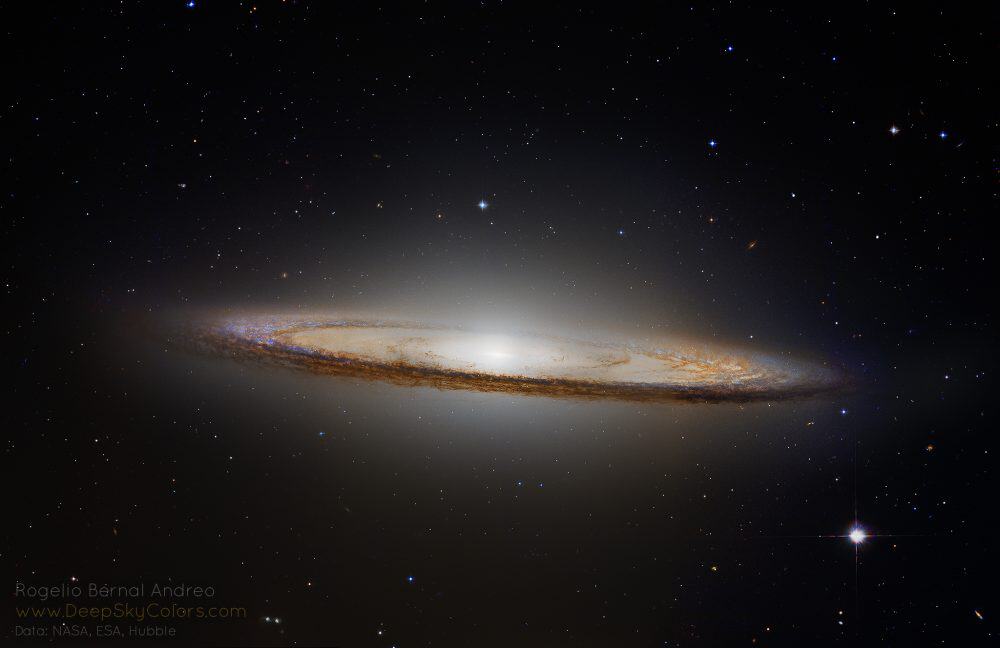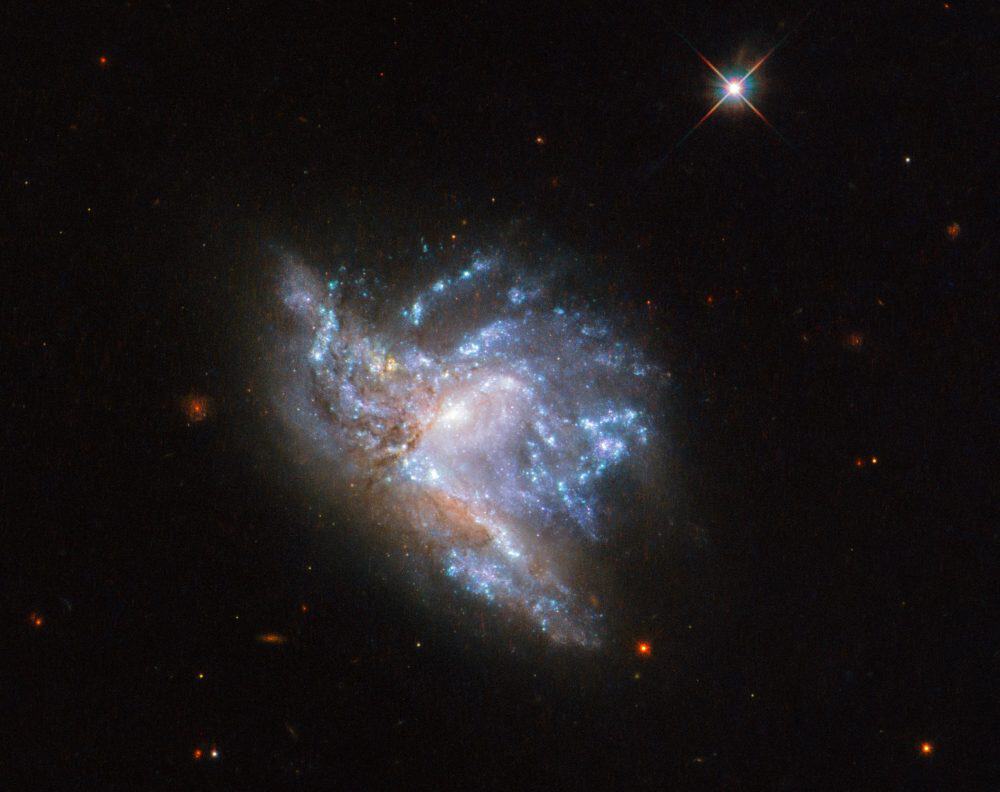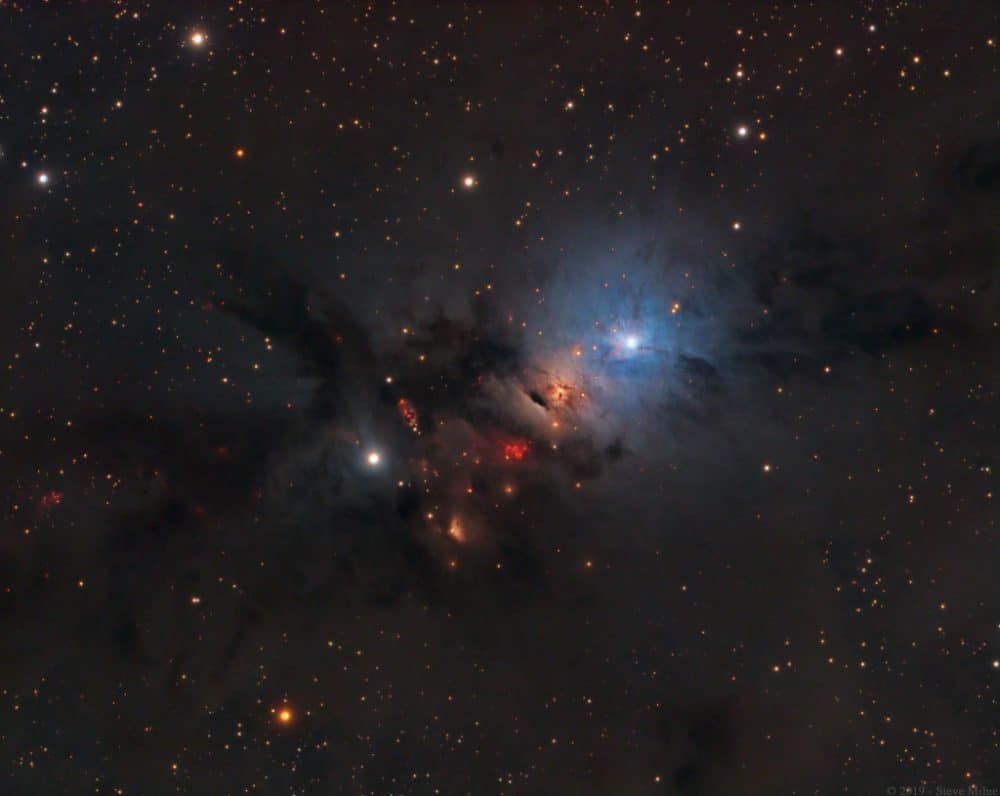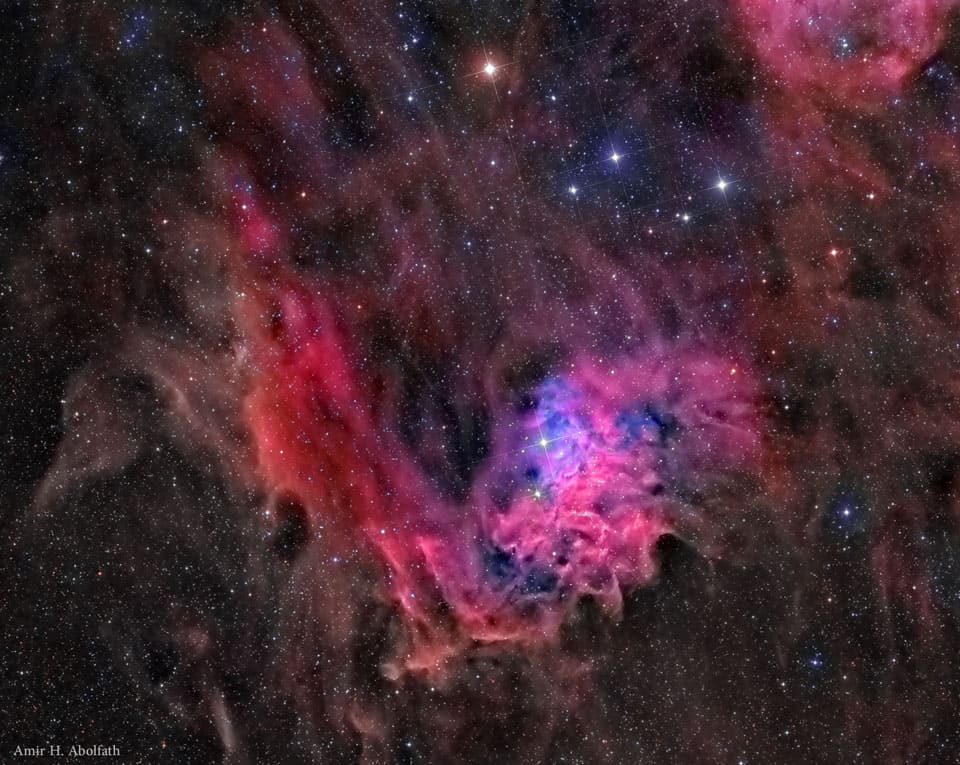Blog
Boys and Girls you will not believe this but next Tuesday April 2nd; I am flying to LA to be on Judge Judys show, and filming the next day with a tenant I took to court, a real nut case! Whaaa do ya think huh, huh?
Maybe I can be Judys Jester lol
You all will have to call in program and tell them to give me some work in Hollywood! Duh!!
Good Luck mick
We are all gonna have some fun tonight!
Everybody wants to see this so badly I will have to charge admission!
The striking spiral galaxy M104 is famous for its nearly edge-on profile featuring a broad ring of obscuring dust lanes. Seen in silhouette against an extensive central bulge of stars, the swath of cosmic dustlends a broad brimmed hat-like appearance to the galaxy suggesting a more popular moniker, The Sombrero Galaxy. Hubble Space Telescope data have been used to to create this sharp view of the well-known galaxy. The processing results in a natural color appearance and preserves details often lost in overwhelming glare of M104’s bright central bulge when viewed with smaller ground-based telescopes. Also known as NGC 4594, the Sombrero galaxy can be seen across the spectrum and is host to a central supermassive black hole. About 50,000 light-years across and 28 million light-years away, M104 is one of the largest galaxies at the southern edge of the Virgo Galaxy Cluster.
more...Mory Kanté (born 29 March 1950) is a Guinean vocalist and player of the kora harp. He is best known internationally for his 1987 hit song “Yé ké yé ké“, which reached number-one in Belgium, Finland, the Netherlands, and Spain. The album it came from, Akwaba Beach, was the best-selling African record of its time.Mory Kanté was born of mixed Malian and Guinean descent, into one of Guinea’s best known families of griot (hereditary) musicians. After being brought up in the Mandinka griot tradition in Guinea, he was sent to Mali at the age of seven years – where he learned to play the kora, as well as important voice traditions, some of which are necessary to become a griot. As a Muslim, he integrated aspects of Islamic music in his work.
https://www.youtube.com/watch?v=BUV9s9ZjpsQ
Michael Leonard Brecker (March 29, 1949 – January 13, 2007) was an American jazz saxophonist and composer. He was awarded 15 Grammy Awards as both performer and composer. He was awarded an Honorary Doctorate from Berklee College of Music in 2004, and was inducted into the Down Beat Jazz Hall of Fame in 2007.
Michael Brecker was born in Philadelphia and raised in Cheltenham Township, a local suburb. His father Bob (Bobby) was a lawyer who played jazz piano and his mother Sylvia was a portrait artist.[4] Michael Brecker was exposed to jazz at an early age by his father. He grew up as part of the generation of jazz musicians who saw rock music not as the enemy but as a viable musical option. Brecker began studying clarinet at age 6, then moved to alto saxophone in eighth grade, settling on the tenor saxophone as his primary instrument in his sophomore year. He graduated from Cheltenham High School in 1967 and spent that summer at the Berklee College of Music in Boston. After a year at Indiana University he moved to New York City in 1969, where he carved out a niche for himself as a dynamic and exciting jazz soloist. He first made his mark at age 20 as a member of the jazz-rock band Dreams–a band that included his older brother, trumpeter Randy Brecker, trombonist Barry Rogers, drummer Billy Cobham, keyboardist Jeff Kent and bassist Doug Lubahn. Dreams was short-lived, lasting only from 1969 through 1972, but Miles Davis was seen at some gigs prior to his recording Jack Johnson.
more...Flamenco Fridays featuring Taranta. Tarantas and Taranto are two related styles (palos) of Flamenco music, that originated in the Andalusian province of Almería. Each is characterized by a shared modality (F-sharp Phrygian) and harmonic progression (Bm – A7 – G – F-sharp), but differ significantly with respect to rhythm and meter. Tarantas is a cante libre (or toque libre, if played as a solo), meaning that it lacks both a regular rhythmic pattern (compás, in flamenco terminology) and a regular rhythmic unit (or beat). It can be sung or played, but not danced. Taranto, conversely, has a regular 2/4 meter, and is danceable. When played on, or accompanied by, the guitar, both palos have a unique and characteristic sound that is created, in part, by dissonances that result from the use of the guitar’s first three open strings (E, B, and G, respectively), in combination with harmonies and melodies based on the F-sharp Phrygian mode
more...
Located in the constellation of Hercules, about 230 million light-years away, NGC 6052 is a pair of colliding galaxies. They were first discovered in 1784 by William Herschel and were originally classified as a single irregular galaxy because of their odd shape. However, we now know that NGC 6052 actually consists of two galaxies that are in the process of colliding. This particular image of NGC 6052 was taken using the Wide Field Camera 3 on the NASA/ESA Hubble Space Telescope.
A long time ago gravity drew the two galaxies together into the chaotic state we now observe. Stars from within both of the original galaxies now follow new trajectories caused by the new gravitational effects. However, actual collisions between stars themselves are very rare as stars are very small relative to the distances between them (most of a galaxy is empty space). Eventually things will settle down and one day the two galaxies will have fully merged to form a single, stable galaxy.
Our own galaxy, the Milky Way, will undergo a similar collision in the future with our nearest galactic neighbour, the Andromeda Galaxy. Although this is not expected to happen for around 4 billion years so there is nothing to worry about just yet.
more...Stefani Joanne Angelina Germanotta (born March 28, 1986 Lenox Hill Hospital in Manhattan, New York City), known professionally as Lady Gaga, is an American singer, songwriter and actress. She is known for her unconventionality, provocative work, and visual experimentation. She began performing as a teenager, singing at open mic nights and acting in school plays. She studied at Collaborative Arts Project 21, through New York University‘s Tisch School of the Arts, before dropping out to pursue a music career. When Def Jam Recordings canceled her contract, she worked as a songwriter for Sony/ATV Music Publishing, where Akon helped her sign a joint deal with Interscope Records and his own label KonLive Distribution in 2007. She rose to prominence the following year with her debut album, the electropop record The Fame, and its chart-topping singles “Just Dance” and “Poker Face“. A follow-up EP, The Fame Monster (2009), featuring the singles “Bad Romance“, “Telephone” and “Alejandro“, was also successful.
Gaga’s second full-length album, Born This Way (2011), explored electronic rock and techno-pop. It peaked atop the US Billboard 200 and sold more than one million copies in the country in its first week. Its title track became the fastest selling song on the iTunes Store with over a million downloads in less than a week. Gaga experimented with EDM on her third studio album, Artpop (2013), which reached number one in the US and included the single “Applause“. Her collaborative jazz album with Tony Bennett, Cheek to Cheek (2014), and her soft rock-influenced fifth studio album, Joanne (2016), also topped the US charts. During this period, Gaga ventured into acting, playing leading roles in the miniseries American Horror Story: Hotel (2015–2016), for which she received a Golden Globe Award for Best Actress, and the critically acclaimed musical drama A Star Is Born (2018), for which she was nominated for the Academy Award for Best Actress. She also contributed to the latter’s soundtrack, which received a BAFTA Award for Best Film Music and made her the only woman to achieve five US number one albums in the 2010s. Its lead single, “Shallow“, topped the US charts and earned Gaga the Academy Award for Best Original Song.
Having sold 27 million albums and 146 million singles as of January 2016, Gaga is one of the best-selling music artists in history. Her achievements include several Guinness world records, nine Grammy Awards, an Academy Award, a BAFTA Award, two Golden Globe Awards, and an award from the Songwriters Hall of Fame and the Council of Fashion Designers of America. She has been declared Billboard‘s Artist of the Year and included among Forbes‘s power and earnings rankings. She was ranked number four on VH1‘s Greatest Women in Music in 2012 and second on Time‘s 2011 readers’ poll of the most influential people of the past ten years, and was named Billboard‘s Woman of the Year in 2015. She is known for her philanthropy and social activism, including her work related to LGBT rights, and for her nonprofit organization, the Born This Way Foundation, which focuses on empowering youth and preventing bullying.
more...Donald Ray Brown (born March 28, 1954) is an American jazz pianist and producer.
Brown was born in Hernando, Mississippi and raised in Memphis, Tennessee, where he learned to play trumpet and drums in his youth. From 1972 to 1975 he was a student at Memphis State University, by which time he had made piano his primary instrument. He was with Art Blakey‘s Jazz Messengers from 1981 to 1982, then took teaching positions at Berklee College of Music from 1983 to 1985 and the University of Tennessee from 1988.[2] Brown has recorded for Evidence, Muse, and Sunnyside.
more...Thaddeus Joseph Jones (March 28, 1923 – August 20, 1986) was an American jazz trumpeter, composer, and bandleader who has been called “one of the all-time greatest jazz trumpet soloists.”
After his military service, which included an association with the U.S. Military School of Music and working with area bands in Des Moines and Oklahoma City, Jones became a member of the Count Basie Orchestra in May 1954. He was featured as a soloist on such well-known tunes as “April in Paris“, “Shiny Stockings” and “Corner Pocket”. However, his main contribution to Basie’s organization was nearly two dozen arrangements and compositions, which included “The Deacon”, “H.R.H.” (Her Royal Highness — in honor of the band’s command performance in London), “Counter Block”, and lesser known tracks such as “Speaking of Sounds”. His hymn-like ballad “To You” was performed by the Basie band combined with the Duke Ellington Orchestra in their only recording together, and the recording Dance Along With Basie contains nearly an entire album of Jones’ uncredited arrangements of standard tunes.
In 1959 Jones played cornet on Thelonious Monk‘s 5 by Monk by 5 album.
more...NGC 1333 is seen in visible light as a reflection nebula, dominated by bluish hues characteristic of starlight reflected by interstellar dust. A mere 1,000 light-years distant toward the heroic constellationPerseus, it lies at the edge of a large, star-forming molecular cloud. This striking close-up spans about two full moons on the sky or just over 15 light-years at the estimated distance of NGC 1333. It shows details of the dusty region along with telltale hints of contrasty red emission from Herbig-Haro objects, jets and shocked glowing gas emanating from recently formed stars. In fact, NGC 1333 contains hundreds of stars less than a million years old, most still hidden from optical telescopes by the pervasive stardust. The chaotic environment may be similar to one in which our own Sun formed over 4.5 billion years ago.
more...John Clyde Copeland (March 27, 1937 – July 3, 1997) was an American Texas blues guitarist and singer. In 1983 he was named Blues Entertainer of the Year by the Blues Foundation. He is the father of blues singer Shemekia Copeland.
In 2017, Copeland was posthumously inducted in to the Blues Hall of Fame.
Copeland was born in Haynesville, Louisiana. Influenced by T-Bone Walker, he formed the Dukes of Rhythm in Houston, Texas, and made his recording debut in 1956, signing with Duke Records the following year. Although his early records met with little commercial success, he became a popular touring act over the next two decades.
His early recording career embraced blues, soul and rock and roll. He recorded singles for Mercury, Golden Eagle and All Boy, amongst others. His first single was “Rock ‘n’ Roll Lily”, and he later cut successes such as “Down on Bending Knees” and “Please Let Me Know”. For the most part, his singles featured Copeland as a vocalist more than a guitar player.
Driven by disco to rethink his future, he moved to New York City in 1979, and played extensively in Eastern cities. In New York he met a young record producer named Dan Doyle who was instrumental in getting Copeland signed with Rounder Records. Doyle produced Copeland’s initial Rounder releases including Copeland Special for which he won a W. C. Handy Award in 1981, and Bringing It All Back Home (1985). Copeland also recorded with Albert Collins and Robert Cray, winning a Grammy in 1987 for Best Traditional Blues Album, for the album Showdown!.
https://www.youtube.com/watch?v=cnGTFeaievs
more...Sarah Lois Vaughan (March 27, 1924 – April 3, 1990) was an American jazz singer.
Nicknamed “Sassy” and “The Divine One“, she won four Grammy Awards, including the Lifetime Achievement Award. She was given an NEA Jazz Masters Award in 1989. Critic Scott Yanow wrote that she had “one of the most wondrous voices of the 20th century”.
Vaughan’s father, Asbury “Jake” Vaughan, was a carpenter by trade and played guitar and piano. Her mother, Ada Vaughan, was a laundress who sang in the church choir. The Vaughans lived in a house on Brunswick Street in Newark for Vaughan’s entire childhood. Jake was deeply religious. The family was active in New Mount Zion Baptist Church at 186 Thomas Street. Vaughan began piano lessons at age 7, sang in the church choir, and played piano for rehearsals and services.
more...Benjamin Francis Webster (March 27, 1909 – September 20, 1973) was an American jazz tenor saxophonist. He is considered one of the three most important “swing tenors” along with Coleman Hawkins and Lester Young. Known affectionately as “The Brute” or “Frog”, he had a tough, raspy, and brutal tone on stomps (with growls), yet on ballads he played with warmth and sentiment. He was indebted to alto saxophonist Johnny Hodges, who, he said, taught him to play his instrument.
https://www.youtube.com/watch?v=Yqz9K3LICiQ
more...https://www.youtube.com/watch?v=C1IaHEGGn54
more...AE Aurigae is named the flaming star, the surrounding nebula IC 405 is named the Flaming Star Nebula, and the region shape gives the appearance of fire, there is no fire. Fire, typically defined as the rapid molecular acquisition of oxygen, happens only when sufficient oxygen is present and is not important in such high-energy, low-oxygen environments such as stars. The material that appears as smoke is mostly interstellar hydrogen, but does contain smoke-like dark filaments of carbon-rich dust grains. The bright star AE Aurigae, visible just to the lower right of the image center, is so hot it glows blue, emitting light so energetic it knocks electrons away from surrounding gas. When a proton recaptures an electron, light is emitted, as seen in the surrounding emission nebula. Featured here, the Flaming Star nebula lies about 1,500 light years distant, spans about 5 light years, and is visible with a small telescope toward the constellation of the Charioteer (Auriga).
more...Diana Ross (born March 26, 1944 Detroit, MI) is an American singer, actress, and record producer. Born and raised in Detroit, Michigan, Ross rose to fame as the lead singer of the vocal group the Supremes, which, during the 1960s, became Motown’s most successful act, and are the best charting girl group in US history, as well as one of the world’s best-selling girl groups of all time. The group released a record-setting twelve number-one hit singles on the US Billboard Hot 100, including “Where Did Our Love Go“, “Baby Love“, “Come See About Me“, “Stop! In the Name of Love“, “You Can’t Hurry Love“, “You Keep Me Hangin’ On“, “Love Child“, and “Someday We’ll Be Together“.
Following her departure from the Supremes in 1970, Ross released her eponymous debut solo album that same year, which contained the Top 20 Pop hit “Reach Out and Touch (Somebody’s Hand)” and the number-one Pop hit “Ain’t No Mountain High Enough“. She later released the album Touch Me in the Morning in 1973; its title track reached number 1, as her second solo No. 1 hit. That same year, her album Lady Sings the Blues, which was the original soundtrack of her film based on the life of jazz singer Billie Holiday, went to no. 1 on the Billboard 200 albums chart, selling more than 300,000 copies within its first 8 days of release.
By 1976, the Mahogany soundtrack included her third number-one hit, “Theme from Mahogany (Do You Know Where You’re Going To)“. Her eponymous 1976 album included her fourth number-one hit, “Love Hangover“. In 1979, Ross released the album The Boss.
Her 1980 semi-eponymous album Diana reached number 2 on the US Billboard albums chart, and spawned the number-one hit “Upside Down“, and the Top 5 international hit “I’m Coming Out“. Ross’ final single with Motown during her initial run with the company achieved her sixth and final US number-one Pop hit, the duet “Endless Love“, composed for Brooke Shields‘ film of the same name, by and performed with Commodores front man, Lionel Richie. Ross and Richie performed the song on the telecast for the 54th Academy Awards, where the song was nominated in the category of “Best Song”. The success of the single launched Richie’s successful solo career.
Ross has also ventured into acting, with a Golden Globe Award and Academy Award-nominated performance for her performance in the film Lady Sings the Blues (1972). She also starred in two other feature films, Mahogany (1975) and The Wiz (1978), later acting in the television films Out of Darkness (1994), for which she also was nominated for a Golden Globe Award, and Double Platinum (1999).
Ross was named the “Female Entertainer of the Century” by Billboard magazine. In 1993, the Guinness Book of World Records declared Ross the most successful female music artist in history, due to her success in the United States and United Kingdom for having more hits than any female artist in the charts, with a career total of 70 hit singles with her work with the Supremes and as a solo artist.
In 1988, Ross was inducted to the Rock and Roll Hall of Fame as member of the Supremes, alongside Mary Wilson and Florence Ballard. She was the recipient of the Kennedy Center Honors in 2007, and the Presidential Medal of Freedom in 2016.
more...More Posts
- Daily roots with Dub Shepherds
- Mayday 2021
- What Happened to Mayday?
- The Cosmos with NGC 3898
- Barrington Levy
- Coke Escovedo
- Percy Heath
- Dick Twardzik
- Frankie Lee Sims
- Flamenco Fridays con Vicente Amigo
- Daily Roots with Vivian Jones
- The Cosmos with NGC 3310
- Willie Nelson
- Ray Baretto
- Toots Thielemans
- Duke Ellington
- World Music with Sinikka Langeland
- Daily Roots with Yabby You
- The Cosmos with PN G054.2-03.4
- John Tchicai




